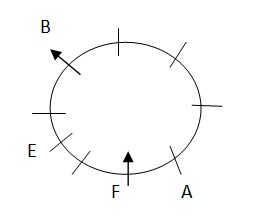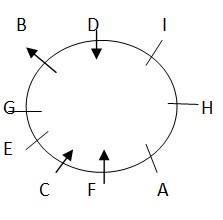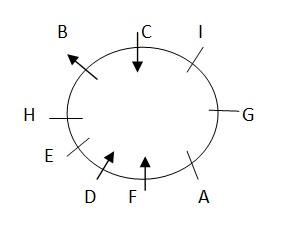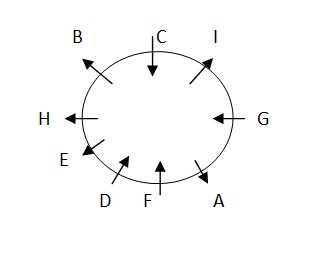Question
What is the position of A with respect to
H? Answer the questions based on the information given below. Nine persons A, B, C, D, E, F, G, H and I sit around a circular table such that only five of them face outside while others face towards the centre. E sits 2nd to the left of F. D and F face towards the centre. One person sits between E and B. A sits 4th to the right of B. H sits 2nd to the left of D. G sits 2nd to the left of C, who doesn’t face same direction as B. I doesn’t sit adjacent to H. Immediate neighbors of G face opposite direction to G. H doesn’t sit with F.Solution
E sits 2nd to the left of F, who faces towards the centre. One person sits between E and B. A sits 4th to the right of B. So, A sits immediate right of F. B faces outside.  H sits 2nd to the left of D, who faces towards the centre. G sits 2nd to the left of C, who doesn’t face same direction as B. H doesn’t sit with F. So, H sits 3rd to the right of B or immediate left of B and C sits immediate left of F or 4th to the right of F. Case I: C sits immediate left of F:
H sits 2nd to the left of D, who faces towards the centre. G sits 2nd to the left of C, who doesn’t face same direction as B. H doesn’t sit with F. So, H sits 3rd to the right of B or immediate left of B and C sits immediate left of F or 4th to the right of F. Case I: C sits immediate left of F:  Case II: C sits 4th to the right of F:
Case II: C sits 4th to the right of F:  I doesn’t sit adjacent to H, so case I is rejected. Immediate neighbors of G face opposite direction to G. So, G must face towards the centre while I and A face outside and H and E face outside. The final seating arrangement is given below:
I doesn’t sit adjacent to H, so case I is rejected. Immediate neighbors of G face opposite direction to G. So, G must face towards the centre while I and A face outside and H and E face outside. The final seating arrangement is given below: 
As per the Sovereign Gold Bond of the RBI, in how many years is premature redemption allowed?
'Dholavira', a site in Indus Valley Civilization is famous for ____________.
What was the theme of World Environment Day 2024?
What is the capital city of the Indian state of Jharkhand?
___________ a Rashtrakuta chief overthrew his Chalukya overlord and performed a rimal called hiranya-garbha (literally, the golden womb).
Which of the following statements about the MSME Minister Narayan Rane's initiatives at the 9th SHAKTI International Women Entrepreneurs Summit is/are c...
In which of the following languages is ‘Childhood Days - A Memoir’ by Satyajit Ray written?
Which mutual fund has successfully raised over Rs 3,400 crore through its new fund offer for the India Manufacturing Fund?
When was the Singh Sabha movement formed in Amritsar?
Which of the following committee had recommended the consolidation of banks -:
Relevant for Exams:


